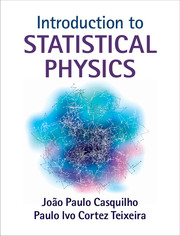Book contents
- Frontmatter
- Dedication
- Contents
- Preface
- Acknowledgements
- 1 Random walks
- 2 Review of thermodynamics
- 3 The postulates of statistical physics. Thermodynamic equilibrium
- 4 Statistical thermodynamics: developments and applications
- 5 The classical ideal gas
- 6 The quantum ideal gas
- 7 Magnetism
- 8 The Ising model
- 9 Liquid crystals
- 10 Phase transitions and critical phenomena
- 11 Irreversible processes
- Appendix A Values of some fundamental physical constants
- Appendix B Some useful unit conversions
- Index
- References
10 - Phase transitions and critical phenomena
Published online by Cambridge University Press: 18 December 2014
- Frontmatter
- Dedication
- Contents
- Preface
- Acknowledgements
- 1 Random walks
- 2 Review of thermodynamics
- 3 The postulates of statistical physics. Thermodynamic equilibrium
- 4 Statistical thermodynamics: developments and applications
- 5 The classical ideal gas
- 6 The quantum ideal gas
- 7 Magnetism
- 8 The Ising model
- 9 Liquid crystals
- 10 Phase transitions and critical phenomena
- 11 Irreversible processes
- Appendix A Values of some fundamental physical constants
- Appendix B Some useful unit conversions
- Index
- References
Summary
Introduction
In this chapter we provide a comprehensive and unified treatment of the physical concepts and quantities relevant to phase transitions and critical phenomena. Some of these concepts and quantities have already been discussed in the particular contexts of magnetism (Chapter 7), or liquid crystals (Chapter 9, We conclude the chapter with a brief reference to the application of renormalisation group ideas to critical phenomena. The resulting reconciliation of the predictions of classical theories with experiments and exact or quasi-exact solutions of model systems is a major triumph of twentieth-century physics.
Phases and phase transitions
Thermodynamics habitually deals with equilibrium systems that are uniform on the macroscopic scale – i.e., where the structure, density and composition are the same throughout the bulk of the system, which is many times greater than a single atom or molecule. Because the system is in equilibrium, intensive thermodynamic variables such as the temperature or chemical potential are also spatially uniform. Such a system is said to consist of a single phase – it is a one-phase system. Phases are what used to be called the states of matter. Solids, liquids, gases and plasmas are four commonly occurring phases – they correspond to the four elements of Aristotelian physics: earth, water, air and fire, respectively. There are, however, many other, less easily identified phases, some of which we have already encountered in this book, such as the ferromagnetic, antiferromagnetic, nematic or superconducting phases.
On varying the temperature, pressure and chemical potential(s) of a system, properties such as its structure, density, composition, compressibility, specific heat, etc., in general change smoothly. Yet under certain conditions the changes may be abrupt – some of these properties may exhibit discontinuities, or even divergences, at a phase transition. Phase transitions are among the most spectacular phenomena of nature. Consider, for instance, the phase sequence of water on heating: from ice, an opaque, slippery, rock-like solid; to colourless, incompressible, liquid water, which nevertheless easily flows under gravity; to water vapour, an invisible and very low-density (greenhouse!) gas, hence of ill-defined volume.
- Type
- Chapter
- Information
- Introduction to Statistical Physics , pp. 269 - 297Publisher: Cambridge University PressPrint publication year: 2014



